|
Prologue
Mr. Sitchin’s words will
appear in quotation marks (" "). Quotation marks within quotation
marks indicate Mr. Sitchin is quoting others.
May I remind the reader, that this attempt to expose Mr. Z. Sitchin’s work, in my opinion magnificent, is to present his work as
it is. No outside comments are required to interpreter his work,
letting Mr. Sitchin, interpret Mr. Sitchin.
However, study of the same is a must, and if disagreement arises,
then please research through the right sources to produce the right
understanding, and so avoid listening unfounded speculations.
I am no scholar, but I am a member of Mankind in search for answers,
and I believe Mr. Zecharia Sitchin has set a valuable opening for
others to continue in the quest!
Following is an excerpt from the Prologue:
"This book suggests
that we are not alone in the solar system. Yet it may enhance
rather than diminish the faith in a universal Almighty for, if
the Nefilim created Man on Earth, they may have only been
fulfilling a vaster Master Plan"
New York, February 1977
A better opening to
Zecharia Sitchin’s work could not be found. In his own words he has
described the essence of his work. It is in this spirit that his
books ought to be read, for the universal Almighty, no matter how
you call it is the same spirit in us, non physical, and yet its
latency is much felt if we connect!
Please Note: Unquoted sentences are mine, either joining extracts
from the book, or a comment in like manner as the above.
Return
Chapter One
THE ENDLESS
BEGINNING
Evolution?
".....It is now recognized that in the normal course of evolution
Man should still be typified by the Bushmen and not by us. It took
Man some 2,000,000 years to advance in his "tool industries" from
the use of stones as he found them to the realization that he could
chip them and shape stones to better suit his purposes. Why not
another 2,000,000 years to learn the use of other materials, and
another 10,000,000 years to master mathematics and engineering and
astronomy?
Yet here we are, less than 50,000 years from
Neanderthal Man,
landing astronauts on the Moon.
|

Apollo 15
Astronaut with Lunar Vehicle on Moon. |
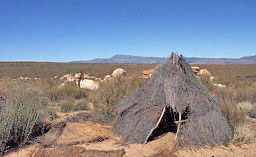
San hut at
Kagga Kamma, "The Bushman Place," South Africa
|
Return
Chapter Two
THE SUDDEN
CIVILIZATION
Rosetta....
" When Napoleon arrived in Egypt in 1799, he took with him scholars
to study and explain these monuments (pyramids, temple-cities half
buried in the sands, guarded by strange stone beasts called
sphinxes). One of his officers found near Rosetta a stone slab on
which was carved a proclamation from 196 B.C. written in the ancient
Egyptian pictographic writing (hieroglyphic) as well as in two other
scripts.
|
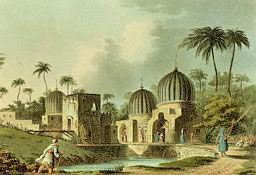
A Capture of a
village near Rosetta, by Luigi Mayer. |
"The decipherment of the
ancient Egyptian script and language, and the archaeological efforts
that followed, revealed to Western man that a high civilization had
existed in Egypt well before the advent of the Greek civilization.
Egyptian records spoke of royal dynasties that began circa 3100 B.C.
- two full millennia before the beginning of Hellenic civilizations.
Reaching its maturity in the fifth and fourth centuries B.C. Greece
was a late comer rather than an originator.
"Was the origin of our civilization, then, in Egypt?
Mr. Z. Sitchin answers this question along his book.
"One of the greatest
finds of Akkadian texts were the ruins of a library assembled in
Nineveh by Ashurbanipal; Layard and his colleagues carted away from
the site 25,000 tablets, many of which were described by the ancient
scribes as copies of "olden texts". A group of twenty tablets ended
with the statement: "23rd tablet: language of Shumer not
changed....."
"...Except for mispronouncing the name - it should have been Shumer,
not Sumer - Oppert was right (January 1869 Jules Oppert). Sumer was
not a mysterious, distant land, but the early name for southern
Mesopotamia, just as the book of Genesis had clearly stated: The
royal cities of Babylon and Akkad and Erech were in "the Land of
Shin’ar." (Shinar was the biblical name for
Shumer).
"The first significant excavation of a Sumerian site was begun in
1877 by French archaeologists and the finds from this single site
were so extensive that others continued to dig there until 1933
without completing the job.
Mr. Sitchin dedicates extensive research on the subsequent findings,
and has included graphics of seals, cuneiform writings, clay
tablets, and pictures in his book. These speak of the rulers of
Sumer and their customs as a civilization.
"As masterful as even the first Sumerian temples were, they
represent but the tip of the iceberg of the scope and richness of
the material achievements of the first great civilization known to
Man
The Sumerians invented writing and printing, the forerunner of our
rotary presses, the cylinder seal.
More than with the divine and spiritual they concerned themselves
with crops, measuring fields, calculating prices. They had a
parallel system of mathematics.
They invented the kiln.
They achieved textile and clothing industries.
They were well achieved in agriculture.
Their culinary art was admirable:
cereals were turned into flour, to produce leavened and unleavened
breads, porridges, pastries, cakes, and biscuits. Barley was also
fermented to produce beer. Wine was obtained from grapes and date
palms. Milk was available from sheep, goats, and cows, it was used
as beveredge, for cooking and for converting into yogurt, butter,
cream and cheeses. Fish was a common part of the diet. Mutton was
readily available and the meat of pigs was considered a delicacy.
"Our admiration for the Sumerian culinary art certainly grows as we
come across poems that sing the praises of fine foods. In deed, what
can one say when one reads a millennia-old recipe for "coq au vin":
In the wine of drinking,
In the scented water,
In the oil of unction -
This bird have I cooked,
and have eaten.
Sumerians engaged in deep-water seafaring. They searched for metals, rare woods, and stones, and other
materials unobtainable in Sumer. The wheel was first used in Sumer, being the first for using ox and
horse power. Following are some "firsts" attributed to Sumerians (from a book by
Samuel N. Kramer, one of the great Sumerologists), these are quoted
by Mr. Sitchin in his own book:
first schools
first bicameral congress
first historian
first pharmacopaeia
first farmer’s almanac
first cosmogony and cosmology
first "Job"
first proverbs and sayings
first library debates
first "Noah"
first library catalogue
first Man’s Heroic Age
first law code and social reforms
first medicine, agriculture and search for world peace and harmony.
"Preceding the biblical book of Ecclesiastes by some two millennia,
Sumerian proverbs conveyed many of the same concepts and witticisms.
Following are some sayings regarding Law and Justice:
If we are doomed to die- let us spend;
If we shall live long- let us save.
When a poor man dies, do not try to revive him.
He who possesses much silver, may be happy;
He who possesses much barley, may be happy;
But who has nothing at all, can sleep!
Man: for his pleasure: Marriage;
On his thinking it over: Divorce.
It is not the heart which leads to enmity;
it is the tongue which leads to enmity.
In a city without watchdogs,
the fox is the overseer.
"The material and
spiritual achievements of the Sumerian civilization were also
accompanied by an extensive development of the performing arts. A
team of scholars from the University of California at Berkeley made
news in March 1974 when they announced that they had deciphered the
world’s oldest song. What professors Richard L. Crocker, Anne D.
Kilmer, and Robert R. Brown achieved was to read and actually play
the musical notes written on a cuneiform tablet from circa 1800 B.C.
found at Ugarit on the Mediterranean coast (now in Syria).
"We always knew", the Berkeley team explained, "that there was music
in the earlier Assirio-Babylonian civilization, but until this
deciphering we did not know that it had the same heptatonic-diatonic
scale that is characteristic of contemporary Western music, and of
Greek music of the first millennium B.C." Until now it was thought
that Western music originated in Greece; now it has been established
that our music - as so much else of Western civilization -
originated in Mesopotamia. This should not be surprising for the
Greek scholar Philo had already stated that the Mesopotamians were
known to "seek worldwide harmony and unison through the musical
tones."
"There can be no doubt that music and song must also be claimed as a
Sumerian "first"
"........Like so many other Sumerian achievements, music and song
also originated in the temples. But, beginning in the service of the
gods, these performing arts soon were also prevalent outside the
temples. Employing the favorite Sumerian play on words, a popular
saying commented on the fees charged by singers: "A singer whose
voice is not sweet is a "poor" singer indeed."
"Many Sumerian love songs have been found, they were undoubtedly
sung to musical accompaniment. Most touching, however, is a lullaby
that a mother composed and sang to her sick child:
Come sleep, come sleep, come to my son.
Hurry sleep to my son;
Put to sleep his restless eyes...
You are in pain, my son;
I am troubled, I am struck dumb,
I gaze up to the stars.
The new moon shines down on your face;
Your shadow will shed tears for you.
Lie, lie in your sleep....
May the goddess of growth be your ally;
May you have an eloquent guardian in heaven;
May you achieve a reign of happy days....
May a wife be your support
May a son be your future lot.
"What is striking about such music and songs is not only the
conclusions that Sumer was the source of Western music in structure
and harmonic composition. No less significant is the fact that as we
hear the music and read the poems, they do not sound strange or
alien at all even in their depth of feeling and their sentiments.
Indeed, as we contemplate the great Sumerian civilization, we find
that not only are our morals and our sense of justice, our laws and
architecture and arts and technology rooted in Sumer, but the
Sumerian institutions are so familiar, so close. At heart, it would
seem, we are all Sumerians.
Finding the First Temple
Dedicated To Enki...
"In 1919, H. R. Hall came upon ancient ruins at a village now called
El-Ubaid. The site gave its name to what scholars now consider the
first phase of the great Sumerian civilization. Sumerian cities of
that period -ranging from northern Mesopotamia to the southern
Zagron foothills -produced the first use of clay bricks, plastered
walls, mosaic decorations, cemeteries with brick-lined graves,
painted and decorated ceramic wares with geometric designs, copper
mirrors, beads of imported turquoise, paint for eye-lids,
copper-headed "tomahawks," cloth, houses, and, above all, monumental
temple buildings.
"Farther south, the archaeologists found
Eridu - the first Sumerian
city, according to ancient texts. As the excavators dug deeper, they
came upon a temple dedicated to Enki, Sumer’s God of Knowledge,
which appeared to have been built and rebuilt many times over. The
strata clearly led the scholars back to the beginnings of Sumerian
civilization: 2500 B.C., 2800 B.C., 3000 B.C., 3500 B.C.
"The spades came upon the foundations of the first temple dedicated
to Enki. Below that, there was virgin soil - nothing had been built
before. The time was circa 3800 B.C. That is when civilization
began.
"It was not only the first civilization in the true sense of the
term. It was a most extensive civilization, all-encompassing, in
many ways more advanced than the other ancient cultures that had
followed it. It was undoubtedly the civilization on which our own is
based.
"Having begun to use stones as tools some 2,000,000 years earlier,
Man achieved this unprecedented civilization in Sumer circa 3800
B.C. And the perplexing fact about this is that to this very day the
scholars have no inkling who the Sumerians were, where they came
from, and how and why their civilization appeared.
"For its appearance was sudden, unexpected, and out of nowhere.
"H. Frankfort (Tell Uquir) called it "astonishing."
Pierre Amiet,
(Elam) termed it "extraordinary." A. Parrot (Sumer) described it as
"a flame which blazed up so suddenly." Leo Oppenheim (Ancient
Mesopotamia) stressed "the astonishing short period" within which
this civilization had arisen. Joseph Campbell (The Masks of God)
summed it up in this way: "With stunning abruptness ... there
appears in this little Sumerian mud garden ... the whole cultural
syndrome that has since constituted the germinal unit of all the
high civilizations of the world."
I sincerely believe that Mr.
Sitchin has chosen the order of the
chapters in "The 12th Planet" in a splendid manner. First he has
showed us, through vast research, that the people of Sumeria were
not much different than we are today. But most important they showed
feelings, emotions, sorrow, desire to contact the sacred and these
may only manifest when reason points to inner self, like in the
relationship of the sorrowful mother who composed a lullaby to
comfort her son and direct her own petitions high above, for the
well being of the child.
I believe these perceptions of
Mr. Sitchin are vital to offer the
complete picture of what is to follow.
Return
Chapter Three
GODS OF HEAVEN
AND EARTH
The Importance of Number 12
Mr. Sitchin takes the reader through the Greek Olympian gods because
through their history it is confirmed that the Greek never claimed
that their gods came from the heavens.
(Rather, they arrived from other lands with traditions and
religion).
Zeus arrived from the Mediterranean, via Crete. Aphrodite, from the
Near East, via Cyprus.
Poseidon (Neptune to the Romans) brought the horse with him from
Asia Minor.
Athena, brought the olive, fertile and self-sown from the lands of
the Bible. And it is in the Mediterranean Island that Mr. Sitchin
looks for the origin of the Greek gods and their astral relationship
with the number 12.
It is known that the Olympian gods could not exceed 12 in number,
nor be less than 12 in number.
The Hittites of the Old Testament also practiced this system of no
more and no less than 12 gods of Heaven and Earth.
Mr. Sitchin also studies the Hindu system of the ancients and finds
a similarity.
To read "The 12th Planet" is a must to be able to appreciate and
understand the correlation.
"What was it that after hundreds of thousands and even millions of
years of painfully slow human development abruptly changed
everything so completely, and in a one-two-three punch - circa
11,000-7400-3800 B.C. transformed primitive nomadic hunters and food
gatherers into farmers and pottery makers, and then into builders of
cities, engineers, mathematicians, astronomers, metallurgists,
merchants, musicians, judges, doctors, authors, librarians, priests?
".....It was summed up by one of the tenths of thousands of ancient
Mesopotamian inscriptions that have been uncovered: "Whatever seems
beautiful, we made by the grace of the gods."
"The gods of Sumer. Who were they?
Over the years, startling evidence has been unearthed!
THE BULL AND THE CROSS.-
"There is now general agreement that the foundations of the distinct
Greek civilization were laid on the Island of Crete, where the
Minoan culture flourished from circa 2700 B.C. to 1400 B.C. In
Minoan myth and legend, the tale of the minotaur is prominent. This
half-man, half-bull was the offspring of Pasiphae, the wife of King Minos and a bull. Archaeological finds have confirmed the extensive
Minoan worship of the bull, and some cylinder seals depict the bull
as a divine being accompanied by a cross symbol, which stood for
some unidentified star or planet. It has therefore been surmised
that the bull worshiped by the Minoans was not the common earthly
creature but the Celestial Bull - the constellation Taurus - in
commemoration of some events that had occurred when the Sun’s spring
equinox appeared in that constellation, circa 4000 B.C.
THE "GOGGLES".-
"The archaeological find showed conclusively that the Hittites
worshiped gods that were of "Heaven and Earth", all
interrelated and
arranged into a genealogical hierarchy. Some were great and "olden" gods who were originally of the heavens.
Their symbol - which in the Hittite pictographic writing meant
"divine" or "heavenly god"- looked like a pair of eyes goggles. It
frequently appeared on round seals as part of a rocket-like object.
"A long and well preserved Hittite epic tale, entitled "Kingship in
Heaven" deals with this very subject - the heavenly origin of the
gods. The recounter of those premortal events first called upon
twelve "mighty olden gods" to listen to his tale and be witnesses to
its accuracy:
Let there listen the gods who are in Heaven,
And those who are upon the dark-hued Earth!
Let there listen, the mighty olden gods.
(The epic tale is very extensive, suffice to say that in it are all
the names mentioned below by Mr. Sitchin and more).
"Who were these "olden gods"? The answer is obvious, for all of them
- Anu, Antu, Enlil, Ninlil, Ea, Ishkur - bear Sumerian names. Even
the name of Teshub, as well as the names of other "Hittite" gods,
were often written in Sumerian scripts to denote their identities.
Also, some of the places named in the action were those of ancient
Sumerian sites.
Mr. Sitchin has taken care of researching also how the Hittites
inherited the Sumerian knowledge, the language was studied at
Hattu-Shash (the capital city) and Sumerian-Hittite vocabularies
were found there.
The bridge were a people called the Hurrians. The
Old Testament
refers to them as the Horites (free people), the Egyptians referred
to their kingdom as the Mitanni. There is confirmation now that they
were the Aryans. (Mr. Sitchin gives a vast explanation about this in
his book)
It was the Hurrians who absorbed and transmitted the religion of
Sumer. This was obvious from the frequent use of the original
Sumerian divine names, epithets, and writing signs.
Even the Hurrian duplicated Sumerian art, its form, its themes, and
its symbols.
There is evidence that the
Hurrians were present in Sumeria in the
third millennium B.C., that they held important positions in Sumer in
the last period of glory, that of the third dynasty of Ur.
|
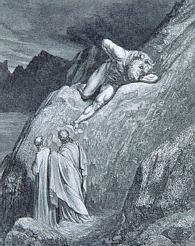
Engraving of
the Minotaur, by Dore, 1861
|

Areal view
of Hittite Ruins
|
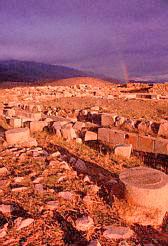
Uraratian
Site in Altintepe, Turkey. They were a people related to
the Hurrians and Hittites and contemporaries of the
Assyrians |
"Over the years, startling evidence has been unearthed...."
Sumerian Father of the
Gods....
Another Symbol "the Winged Star"
EL, the "lofty deity"....
"In the thirteenth century B.C., under the presence of vast
migrations and invasions (including the Israelite thrust from Egypt
to Canaan), the Hurrians retreated to the northeastern portion of
their kingdom. Establishing their new capital near Lake Van, they
called their kingdom Urarty ("Ararat"). There they worshiped a
pantheon headed by Tesheba (Teshub), depicting him as a vigorous god
wearing a horned cap and standing upon his cult symbol, the bull.
They called their main shrine Bitanu ("house of Anu") and dedicated
themselves to making their kingdom "the fortress of the valley of
Anu, as we shall see, was the Sumerian Father of the Gods.
"......The lands that are today
Israel, Lebanon, and southern Syria
-which formed the southwestern band of the ancient Fertile Crescent
-were then the habitat of peoples that can be grouped together as
the Canaanites.
".....The pantheon that unfolds from the Canaanite texts bears many
similarities to the later Greek one. At the head of the Canaanite
pantheon, too, there was a supreme deity called EL, a word that was
the personal name of the god and the generic term meaning "lofty
deity."
"A stela found in Palestine depicts an elderly deity sitting on a
throne and being served a beverage by a younger deity. The seated
deity wears a conical headdress adorned with horns - a mark of the
gods, as we have seen, from prehistoric times - and the scene is
dominated by the Symbol of a Winged Star - the
ubiquitous emblem that
we shall increasingly encounter. It is generally accepted by the
scholars that this sculptured relief depicts EL, the senior
Canaanite deity.
The Winged Star, is a circle in which an eight point star is
enclosed and wings sprang opened from the circle’s each side.
"Whence had the Canaanites, for their part, drawn their culture and
religion?
"The Egyptians believed in Gods of Heaven and Earth. Great Gods that
were clearly distinguished from the multitudes of lesser deities.
G.A. Wainwright (The Sky Religion in Egypt) summed up the evidence,
showing that the Egyptian belief in Gods of Heaven who descended to
Earth from the skies was "extremely ancient." Some of the epithets
of these Great Gods - Greatest God-Bull of Heaven, Lord/Lady of the
Mountains - sound familiar.
"Although the Egyptians counted by the decimal system, their religious affairs were governed by the Sumerian sexagesimal
sixty, and celestial matters were subjected to the divine number
twelve. The heavens were divided into three parts, each comprising
twelve celestial bodies. The afterworld was divided into twelve
parts. Day and night were each divided into twelve hours. And all
these divisions were paralleled by "companies" of gods, which in
turn consisted of - twelve gods each.
"The head of the Egyptian pantheon was
Ra ("creator") who presided
over an Assembly of the Gods that numbered twelve.
"......Ra was an unseen celestial god who manifested himself only
periodically. His manifestation was the ATEN - the Celestial Disc,
depicted as a Winged Globe.
Symbol.- The ATEN was a blank circle with wings spanning from each
side.
Ra had two sons, Osiris and Seth. Horus, son of
Osiris is represented sometimes as a winged and horned
deity. Obviously as representation of the Kingdom from Ra.
"The earlier notion that civilization may have begun in Egypt has
been discarded by now. There is ample evidence now showing that the
Egyptian - organized society and civilization, which began half a
millennium and more after the Sumerian one, drew its culture,
architecture, technology, art of writing, and many other aspects of
a high civilization from Sumer. The weight of evidence also shows
that the gods of Egypt originated in Sumer.
The Canaanites could not boast of an original pantheon. They, too,
acquired their cosmogony, deities, and legendary tales from
elsewhere. Their direct contacts with the Sumerian sources were the
Amorites.
"In the 1980’s archaeologists came upon the center and capital city
of the Amorites, known as Mari. At a bend of the Euphrates, where
the Syrian border now cuts the river, the diggers uncovered a major
city whose buildings were erected and continuously reerected,
between 3000 and 2000 B.C., on foundations that date to centuries
earlier. These earlier remains included a step pyramid and temples
to the Sumerian deities Inanna, Ninhursag, and Enlil.
"Who were these
Gods of Heaven and Earth, divine yet human, always
headed by a pantheon of inner circle and twelve deities?
We have entered the temples of the
Greeks, and the Aryans, the
Hittites and the Hurrians, the Canaanites, the
Egyptians, and the
Amorites. We have followed paths that took us across continents and
seas, and clues that carried us over several millennia.
And all the corridors of all the temples have led us to one source:
Sumer.
|

Lake Van and
Akdamar Island,
Turkey |
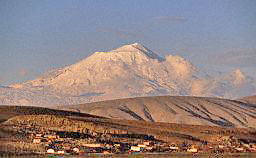
Mount Ararat
and Village of Dogubayazit,Turkey
. |
|

TEL HAZOR
AND GREEN FIELDS
Has revealed 21 levels of occupation. During the time of
the Pre-Israelites it was the leading city of many
kingdoms. An important city along the Via Maris, trade
route between Egypt and the FERTILE CRESCENT. Israel. |
|
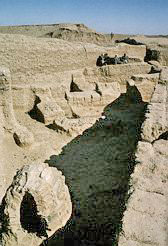
Excavated
Ruins at Mari |
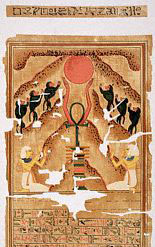
Adoration of
Ra |
Return
Chapter Four
SUMER: LAND OF
THE GODS
Anu, Head of the Family of Gods.... His Symbol
The head of this family of Gods of Heaven and Earth was AN (or
Anu
in the Babylonian/Assyrian texts). He was the Great Father of the
Gods, The King of the Gods. His realm was the expanse of the
heavens, and his symbol was a star. In the Sumerian pictographic
writing, the sign of a star also stood for An, for "heavens" and for
"divine being," or "god" (descended of An). This fourfold of the
symbol remained through the ages, as the script moved from the
Sumerian pictographic to the cuneiform Akkadian, to the stylized
Babylonian and Assyrian."
Symbol.- The star was an eight point star for "An =
star."
An eight point star was also for "heaven", but with four of its arms
(from top) to its left like a sector shape (fan).
A cross with a small inverted triangle on the top arm and with two
small triangles (one above the other) to its left arm, was for
"god."
"The Sumerian claim that not only gods but also selected mortals
could ascend to the Divine Abode in the heavens is echoed in the Old
Testament tales of the ascents to the heavens by Enoch and the
prophet Elijah.
".....Anu had a spouse ANTU.
"A tablet that belonged to an archive at Uruk enlightens us to the
pomp and pageantry that accompany the arrival of Anu and his spouse
on a "state visit." Because of damage to a tablet, we can read of
the ceremonies only from some midpoint, when Anu and Antu were
already seated in the temple’s courtyard. The gods, "exactly in the
same order as before" then formed a procession ahead of and behind
the bearer of the scepter. The protocol then instructed:
They shall then descend to the Exalted Court,
and shall turn towards the god Anu.
The Priest of Purification shall libate the Scepter,
and the Scepter-bearer shall enter and be seated.
The deities Papsukal, Nusku and Shala
shall then be seated in the court of the god Anu.
Many activities would follow.
"While an "evening meal"- various drinks and appetizers - were being
served, an astronomer-priest went up to the "topmost stage of the
tower of the main temple" to observe the skies. He was to look out
for the rising in a specific part of the sky of the planet named
Great Anu of Heaven. Thereupon, he was to recite the compositions
named: "To the one who grows bright, the heavenly planet of the Lord
Anu" and "The Creator’s image has risen."
Among other activities of preparation:
"Meanwhile the whole country was to light up and celebrate the
presence of the two divine visitors. On a signal from the main
temple, the priests from all the other temples of Uruk were "to use
torches to start bonfires"; and the priests in other cities, seeing
the bonfires at Uruk, were to do likewise.
"Then:
The people of the Land will light fires in their homes,
and shall offer banquets to all the gods ....
The guards of the cities shall light fires
in the streets and in the squares."
"The departure of the two Great Gods was also planned, not only to
the day but to the minute.
On the seventeenth day,
forty minutes after sunrise,
the gate shall be opened before the gods Anu and Antu,
bringing to an end their overnight stay.
"By Sumerian tradition, rulership flowed from
Anu; and the very term
for "Kingship" was Anutu (Anu-ship). The insignia of
Anu were the
tiaria (the divine headdress), the scepter (symbol of power), and
the staff (symbolizing the guidance provided by the shepherd). The
shepherd’s staff may now be found more in the hands of bishops than
of kings. But the crown and scepter are still held by whatever kings
Mankind has left on some thrones.
|
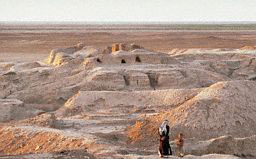
Ruins of the
ancient Sumerian city of Uruk, Iraq |
Return
|











